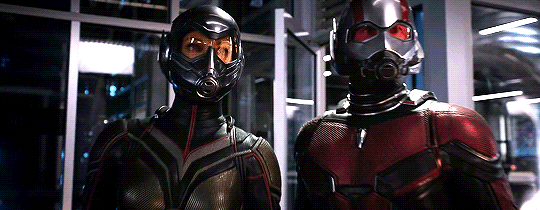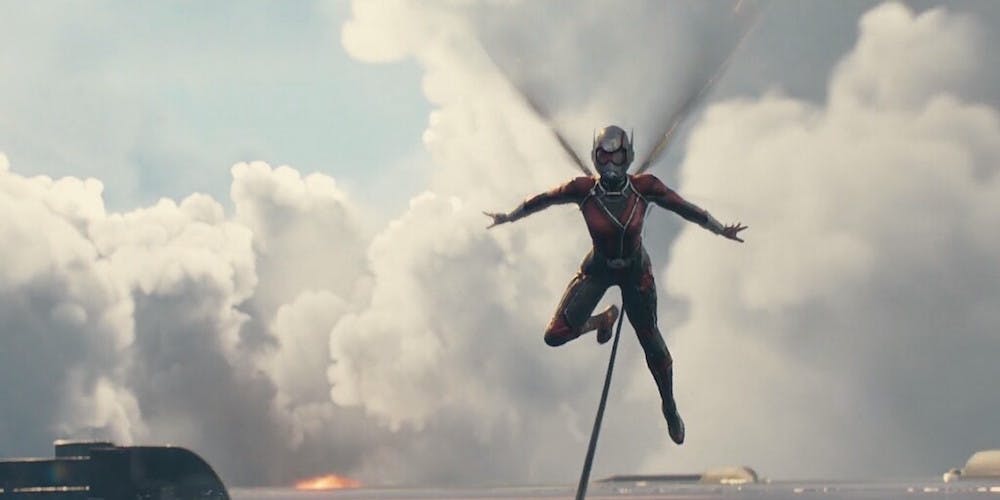Okay, sure, you could say Marvel’s Ant-Man and the Wasp technically has a plot.
Of course there are stakes. Of course the characters want things. And of course risks must be taken in order for their goals to be achieved and for us to experience their shared joy and relief.
It’s just that none of it matters.
As the trailer promises, Ant-Man and the Wasp is a lot of fun. It’s a perfectly mindless summer blockbuster. And with its nonstop special effects, melodramatic subplots, and seemingly endless action sequences, it might just be Marvel’s comic book-iest movie.
But at the same time, Ant-Man and the Wasp is also the least necessary MCU movie yet.
Functionally speaking, Ant-Man and the Wasp serves as a palate cleanser between Avengers main courses. It’s the fruity sorbet to help you wash away the smoky aftertaste of Avengers: Infinity War and prepare you for the leafy greens of next year’s Captain Marvel.
Sure, there are a few plot twists here that may pay off in the next Avengers movie… but judged solely as a standalone entity, Ant-Man and the Wasp is completely skippable.
And to be fair, this isn’t necessarily a bad thing.
On the contrary, it’s kind of remarkable that Marvel can earn billions of dollars worldwide from movies that increasingly feel less like must-see events and more like two-hour episodes of the most expensive sitcom season ever made.
But as inessential as Ant-Man and the Wasp is, one thing about it does stand out:
It may set a Guinness World Record for the most MacGuffins used in a single plot.

WARNING: MILD SPOILERS AHEAD for a movie whose biggest plot points you can probably guess just from its poster.
How Ant-Man and the Wasp Achieve Peak MacGuffin
If you’ve never heard the word before, a MacGuffin is the term Alfred Hitchcock coined for a plot device that gets a film’s characters in motion without much explanation.
“The missing jewels?” That’s a MacGuffin.
“The stolen briefcase?” Also a MacGuffin.
In other words, a MacGuffin is an excuse.
And Ant-Man and the Wasp are full of them.
See, it all starts with Michelle Pfeiffer.

Don’t you forget about me / I’ll be alone, dancing, you know it baby…
As mentioned in the first Ant-Man movie, it was 30 years ago that Doctor Henry “Hank” Pym (Michael Douglas, a.k.a. the original Ant-Man) and his wife Janet van Dyne (Michelle Pfeiffer, a.k.a. the original Wasp) needed to stop a missile that was headed for… uh, somewhere.
And the only way to stop it was for one of them to shrink down to submolecular size because… uh, reasons.
But Hank’s size regulator was busted because… uh… plot convenience?
So Janet sacrificed herself to destroy the missile, and she’s been trapped in the quantum realm ever since. (Do you sense an excuse to have a sequel? I hope you said yes, because…)
In the time between the first Ant-Man movie and this one, Hank and his daughter Hope van Dyne (Evangeline Lilly, a.k.a. the new Wasp) have been hiding from the government because… uh, more reasons.

Worst hide-and-seekers ever.
During that time, Hank built a high-tech lab that’s capable of entering the quantum realm. Why? Because he believes he can rescue his wife Janet.
But there’s a problem: the quantum tunnel isn’t stable. They need one more part.
What does it do? Doesn’t matter. That part is a MacGuffin.
But so is the lab itself.
Hell, even the remote control that Hank uses to shrink the lab is a MacGuffin.

As a general rule, any item that’s mentioned by name in Ant-Man and the Wasp is a future MacGuffin that will give the characters an excuse to run around later.
Which characters? All of them.
Ant-Man and the Wasp is a wild goose chase, in which a lengthy cast of characters spend two hours chasing each other in various directions like It’s a Mad, Mad, Mad, Mad World with a $160 million budget.
A MacGuffin by Any Other Name Would Smell as Contrived
Here’s a quick rundown of the many excuses masquerading as a plot in Ant-Man and the Wasp:
Hank and his daughter Hope desperately need that last quantum tunnel part, so they convince Scott Lang (Paul Rudd, a.k.a. Ant-Man) to start breaking the laws of society and physics to help them retrieve it from evil businessman Sonny Burch (Walton Goggins, who does the max with a minor role).

Me? Oh, just holding this MacGuffin…
Of course this all happens during the last 72 hours of Scott’s house arrest for violating the Sokovia Accords in Captain America: Civil War, which means Scott spends the whole movie racing against time to help Hank and Hope save Janet while trying to avoid getting caught breaking his 24-7 curfew by FBI agent Jimmy Woo (a scene-stealing Randall Park).

Jimmy Woo is basically the Barney Fife of the FBI.
Of course the quantum tunnel just so happens to be the only thing that can cure Ghost (Hannah John-Kamen) before she phases into non-existence, which is why she’s hellbent on… stealing it? Or something? Why can’t she just work with… I mean… I guess it’s because… actually, just don’t worry about it, it’s a MacGuffin.

Totally ready for a fight scene on Hoth.
And of course this is all happening during literally the last two hours Hank and Hope can possibly locate Janet in the depths of the quantum realm “before the coordinates shift and they won’t be stable again for another century.” (Yes, in this movie, even time itself is a MacGuffin.)
Oh, and did I mention that Scott’s ex-con buddies Luis (Michael Peña), Dave (T.I.), and Kurt (David Dastmalchian) started a security company that’s teetering on the verge of bankruptcy… but that all changes if they can land this one huge client… but the plans for their pitch have to be finished by morning? Because of course they do.

I stole the first movie so hard, this time they gave me third billing!!!
And don’t even get me started on Cassie’s (Abby Ryder Forston) missing soccer cleats, or Bill Foster’s (Laurence Fishburne, a.k.a. the original Goliath) entire existence in this movie.
Just as Winston Churchill once described Russia as “a riddle, wrapped in a mystery, inside an enigma,” his fellow countryman Alfred Hitchcock would probably describe the plot of Ant-Man and the Wasp as five layers of MacGuffin stuffed inside one another and half-baked.
A MacGuffin turducken, if you will.
But Wait… Isn’t That Just a Normal Plot?
Not exactly.

Time to go chase someone who has something — OR ARE WE BEING CHASED, WAIT I FORGET
One difference between a MacGuffin and a traditional plot point is that a plot point is a point of no return: once a character makes a choice, there is no going back.
But with a MacGuffin (the stolen plans! the mystery guest! the lady in red!), that all-important item can change hands repeatedly without resulting in any real consquences.
Even time and death feel like MacGuffins in Ant-Man and the Wasp.
What happens if Scott gets busted by the FBI? He probably goes to jail for awhile, where he won’t get to see his daughter for a few years… but otherwise, nothing permanent.
What happens if they don’t rescue Janet or stop Ghost? It’s unclear.
Sure, probably something bad, but not necessarily irreversible. More like… temporarily inconvenient. (After all, as comic book fans know, there’s not much in comics that isn’t reversible, so why should the movies be any different?)

Don’t worry, it’s just a phase.
And again, the fact that Ant-Man and the Wasp is essentially a Russian nesting doll of MacGuffins isn’t inherently a bad thing. It actually works quite well as an antidote to the heavy-handedness of Avengers: Infinity War, which felt Pointedly Important but also Probably All Just Temporarily Inconvenient.
It’s refreshing to counterbalance all that thematic weight with a breezy comedy that only wants its characters to end up happy.
Temporarily, anyway.
One Last Thought
You know how every Marvel movie is really just Iron Man all over again?
Well, Ant-Man and the Wasp also covers all those same bases, like:
- Guy in a super-powered suit saves the world
- Hero’s technology inadvertently creates villain
- Kick-ass female sidekick helps hero save the day
- Lovable pal provides comic relief
- Hapless government agent gets in the way
But it does depart from the usual Marvel formula in one notable way.
Usually, even at their worst, Marvel’s villains have a point. We may not agree with them, but we can at least see why they think they’re justified in the actions they take.
Over the past decade, Marvel’s villains have evolved from blatantly evil industrialists (Obadiah Stane in Iron Man) and power-hungry war criminals (Red Skull in Captain America) to more nuanced maniacs like the Winter Soldier (who turned out to be a pawn in Hydra’s game) and Hela (who may have been casually genocidal, but hey, that was the norm in her day).
With Black Panther‘s Killmonger and Infinity War‘s Thanos, we reached the “I disgree with their means, not their ends” era of Marvel villainy. Here, most filmgoers had to admit that Wakanda probably should have done something about global racism, and overpopulation at the expense of a planet’s natural resources is a problem worth solving. (Maybe not by arming entire nations with black market technology or wiping out half the universe’s population, but still.)
But with Ghost, Ant-Man and the Wasp finally achieves an MCU first:
A film with no true villain.

Don’t tell Patrick Swayze about this.
Yes, Ghost is violent — but just like Winter Soldier and Killmonger, the government made her that way.
Yes, Ghost is (literally) unstable — but just like Whiplash in Iron Man 2, the hero’s technology made her that way.
And yes, Ghost is desperate to steal, kill, and do whatever it takes to cure herself — but when the alternative is literally ceasing to exist (probably), that’s kind of justifiable.
Call Ghost a thematic allegory for the casualties of Silicon Valley excess, or a nod to our current “everything is a grey area in a post-truth world” political era, or even a commentary on the impossibilities of the U.S. healthcare system. But the one thing you can’t call her is evil.
As for Sonny Burch?
Sure, you could say he’s a “villain” in the classic sense. He does have a thing for guns, knives, and foreboding syringes. But he never clearly articulates what he’d actually do if he acquired Pym’s technology. He just spends the whole movie chasing it because it’s important, not because it matters.
A real villain has a plan.
All Burch ever has is a MacGuffin.
Like This?
Share this post on Facebook or Twitter. (Sharing is caring, yo.)
Subscribe to my newsletter and you’ll never miss a new post. (I email it weekly-ish).
You may also like the story problems in Jurassic World: Fallen Kingdom, or why Black Sails has one of the best main characters in TV history.
The Biggest Story Problems in Jurassic World: Fallen Kingdom


0 Comments